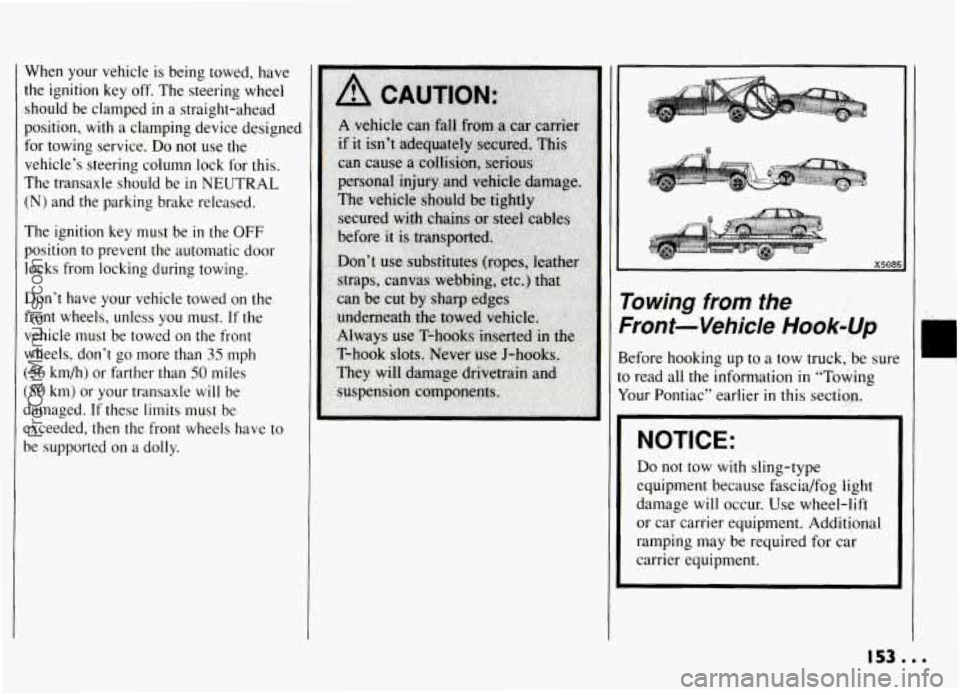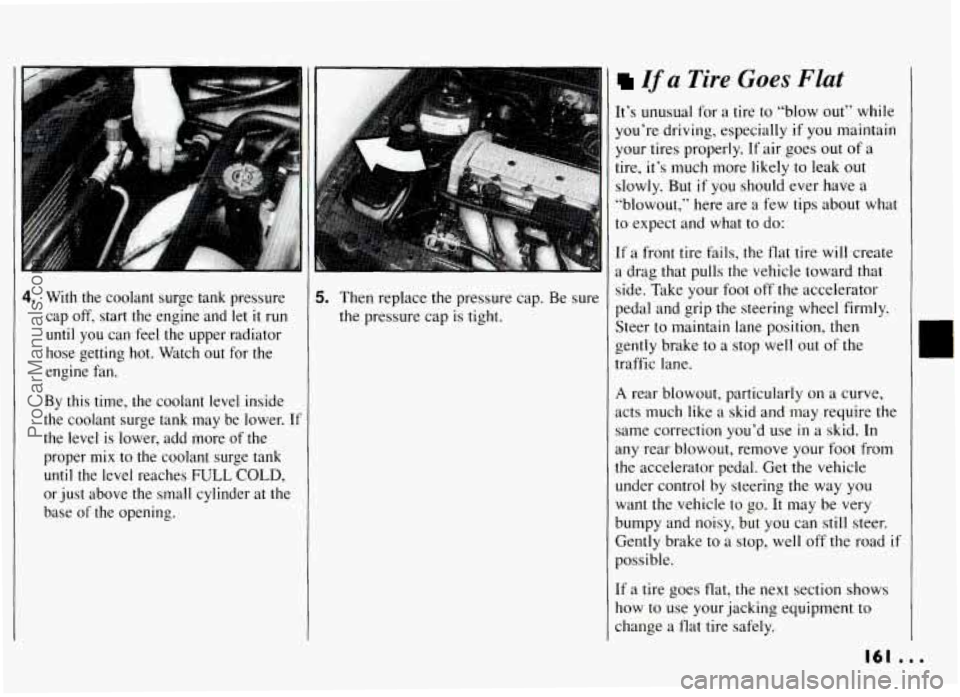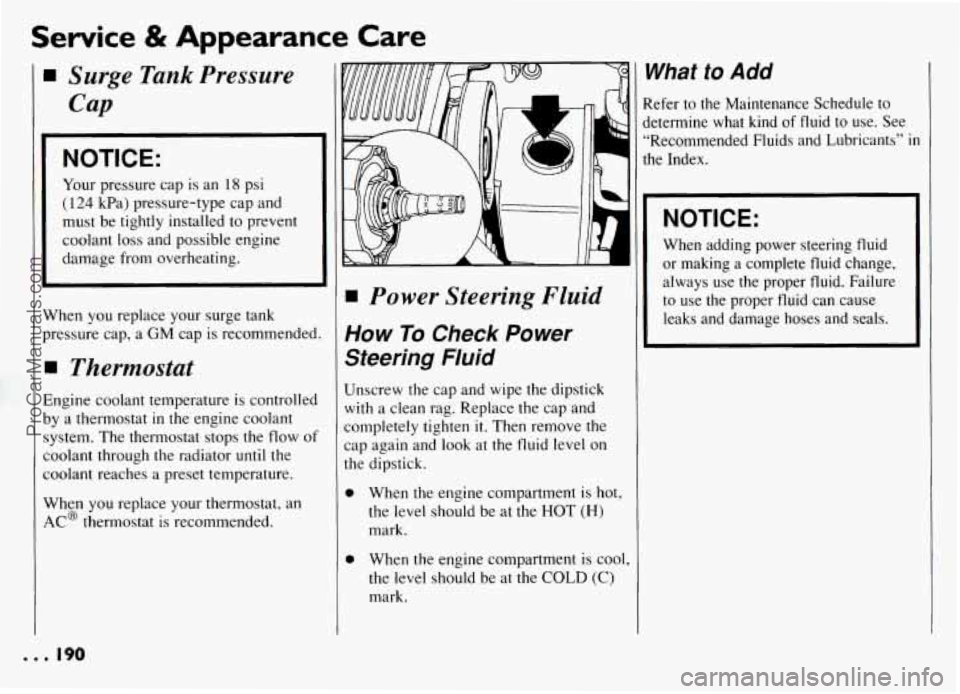Page 141 of 274
Your Driving and the Road
Towing Your Pontiac from the Front
(CONT.)
If you have a manual transaxle, you may
tow your vehicle
with all four wheels on
the ground. Follow these steps:
1.
2.
3.
Set the parking brake.
Turn the ignition key to OFF to unlocl
the steering wheel. See “Ignition”
in
the Index.
Clamp the steering wheel in a
straight-ahead position, with a
clamping device designed for towing.
. Shift your manual transaxle to
NEUTRAL (N).
. Release the parking brake.
NOTICE:
Make sure that the towing speed
does not exceed
55 mph (90 km/h),
or your Pontiac could be badly
damaged.
m 8
T owing your Pontiac from the Rear
NOTICE:
Do not tow your Pontiac from the
rear, or your vehicle could be badly
damaged and the costly repairs
would not be covered by your
warranty.
ProCarManuals.com
Page 145 of 274

Your Driving and the Road
I Driving with a Trailer
Towing a trailer requires a certain amount
of experience. Before setting out for the
open road, you’ll want to get to know
your rig. Acquaint yourself with the feel
of handling and braking with the added
weight
of the trailer. And always keep in
mind that the vehicle you are driving is
now a good deal longer and not nearly
so
.responsive as your vehicle is by itself.
Before you start, check the trailer hitch
and platform, safety chains, electrical
connector, lights, tires and mirror
adjustment. If the trailer has electric
brakes, start your vehicle and trailer
moving and then apply the trailer brake
controller by hand to be sure the brakes
are working. This lets you check your
electrical connection at the same time.
During your trip, check occasionally to be
sure that the load is secure, and that the
lights and any trailer brakes are still
working.
Following Distance
Stay at least twice as far behind the
vehicle ahead as you would when driving
your vehicle without a trailer. This can
help you avoid situations that require
heavy braking and sudden turns.
Passing
You’ll need more passing distance up
ahead when you’re towing a trailer. And,
because you’re a good deal longer, you’ll
need to go much farther beyond the
passed vehicle before you can return to
your lane.
Backing Up
Hold the bottom of the steering wheel
with one hand. Then, to move the trailer
to the left, just move that hand to the left.
To move the trailer to the right, move
your hand to the right. Always back up
slowly and,
if possible, have someone
guide you.
Making Turns
When you’re turning with a trailer, make
wider turns than normal. Do this
so your
railer won’t strike soft shoulders, curbs,
road signs, trees, or other objects. Avoid
ierky or sudden maneuvers. Signal well
in
3dvance.
Turn Signals When
Towing
a Trailer
When you tow a trailer, your vehicle has
to have a different turn signal flasher and
extra wiring. The green arrows on your
instrument panel will flash whenever you
signal a
turn or lane change. Properly
hooked up, the trailer lights will also
flash, telling other drivers you’re about to
turn, change lanes or stop.
When towing a trailer, the green arrows
on your instrument panel will flash for
turns even
if the bulbs on the trailer are
burned out. Thus, you may
think drivers
behind you are seeing your signal when
they are not. It’s important to check
occasionally to be sure the trailer bulbs
are still working.
. . . 144
ProCarManuals.com
Page 154 of 274

When your vehicle is being towed, have
the ignition key off. The steering wheel
should be clamped
in a straight-ahead
position,
with a clamping device designed
for towing service.
Do not use the
vehicle’s steering column lock for this.
The transaxle should be
in NEUTRAL
(N) and the parking brake released.
The ignition key must be in the OFF
position to prevent the automatic door
locks from locking during towing.
Don’t have your vehicle towed on the
front wheels, unless you must. If the
vehicle must be towed on the front
wheels, don’t go more than
35 mph
‘56 i. km/h) or farther than 50 miles
:SO km) or your transaxle will be
ilamaged. If these limits must be
:xceeded, then the front wheels have to
,e supported on a dolly.
,I 7
F
B
tc
Y
I
1
‘owing from the
?ont-Vehicle Hook-Up
efore hooking up to a tow truck, be sur(
1 read all the information in “Towing
our Pontiac” earlier
in this section.
NOTICE:
Do not tow with sling-type
equipment because fascia/fog light
damage will occur. Use wheel-lift
or car carrier equipment. Additional
ramping may be required for car
carrier equipment.
153...
ProCarManuals.com
Page 162 of 274

7
4. With the coolant surge tank pressure
cap off, start the engine and let
it run
until you can feel the upper radiator
hose getting hot. Watch out for the
engine fan.
By this time, the coolant level inside
the coolant surge tank may be lower. If
the level is lower, add more
of the
proper
mix to the coolant surge tank
until the level reaches FULL COLD,
or just above the small cylinder at the
base
of the opening.
I
5. Then replace the pressure cap. Be sure
the pressure cap is tight.
If a Tire Goes Flat
It’s unusual for a tire to “blow out” while
you’re driving, especially
if you maintain
your tires properly. If air goes out
of a
tire, it’s much more likely to leak out
slowly. But if you should ever have a
“blowout,” here are
a few tips about what
to expect and what to do:
If a front tire fails, the flat tire will create
a drag that pulls the vehicle toward that
side. Take your foot off the accelerator
pedal and grip
the steering wheel firmly.
Steer to maintain lane position, then
gently brake to
a stop well out of the
traffic lane.
A rear blowout, particularly on a curve,
acts much like a skid and may require
the
same correction you’d use in a skid. In
my rear blowout, remove your foot from
the accelerator pedal. Get the vehicle
under control by steering the way you
want the vehicle to go. It may be very
wmpy and noisy, but you can still steer.
Sently brake to a stop, well off the road if
Jossible.
[fa tire goes flat, the next section shows
low to use your jacking equipment to
:hange a
flat tire safely.
161 ...
ProCarManuals.com
Page 169 of 274
Problems on the Road
NOTICE:
Spinning your wheels can destroy
parts of your vehicle
as well as the
tires. If you spin the wheels too fast
while shifting your transaxle back
and forth, you can destroy your
transaxle.
..
locking Your Vehicle to Get it Out:
‘irst, turn your steering wheel left and
ight. That will clear the area around your
ront wheels. Then shift back and forth
letween REVERSE (R) and a forward
ear (or with a manual transaxle, between
IRST
(1) or SECOND (2) and
.EVERSE
(R)), spinning the wheels as
ttle as possible. Release
the accelerator
edal while you shift, and press lightly
on
le accelerator pedal when the transaxle is
1 gear. If that doesn’t get you out after a
:w tries, you may need to be towed out.
F you do need to be towed out, see
Towing Your Pontiac”
in the Index.
ProCarManuals.com
Page 178 of 274
2.3L Quad OHC and Quad
4 Engines (CODES 3,
D AND A)
When you open the hood, you'll see:
1. Automatic Transaxle Dipstick
(if'equipped)
2. Brake Fluid Reservoir
3. Air Cleaner
4. Hydraulic Clutch Fluid Reservoir
(if so equipped)
5. Battery
6. Windshield Washer Fluid Reservoir
7. Power Steering Fluid Reservoir
B. Engine Oil Fill Cap, Engine Oil
Dipstick
3. Engine Coolant Surge Tank
ProCarManuals.com
Page 179 of 274
Service & Appearance Care
3.IL V6 Engine (CODE M)
When you open the hood, you’ll see:
1. Power Steering Fluid Reservoir
2. Automatic Transaxle Fluid Dipstick
3. Brake Fluid Reservoir
4. Air Cleaner
5. Battery
6. Windshield Washer Fluid Reservoir
7. Engine Oil Dipstick
8. Engine Oil Fill Cap
9. Engine Coolant Surge Tank
ProCarManuals.com
Page 191 of 274

Service & Appearance Care
V
P
I
E
b
S’
C
C.
P
A
I Surge Tank Pressure
Cap
NOTICE:
Your pressure cap is an 18 psi
( 124 kPa) pressure-type cap and
must be tightly installed to prevent
coolant
loss and possible engine
damage from overheating.
irhen you replace your surge tank
ressure cap, a GM cap is recommended.
I Thermostat
lngine coolant temperature is controlled
y a thermostat in the engine coolant
ystem. The thermostat stops the flow
of
oolant through the radiator until the
oolant reaches a preset temperature.
Jhen you replace your thermostat, an
.C@ thermostat is recommended.
Power Steering Fluid
How To Check Power
Steering Fluid
Unscrew the cap and wipe the dipstick
with a clean rag. Replace the cap and
completely tighten
it. Then remove the
cap again and
look at the fluid level on
the dipstick.
0
0
When the engine compartment is hot,
the level should be at the HOT
(H)
mark.
When the engine compartment is cool,
the level should be at the
COLD (C)
mark.
1
I
1
What to Add
Refer to the Maintenance Schedule to
jetermine what kind
of fluid to use. See
“Recommended Fluids and Lubricants”
in
the Index.
NOTICE:
When adding power steering fluid
or making a complete fluid change,
always use the proper fluid. Failure
to use the proper fluid can cause
leaks and damage hoses and seals.
... 190
ProCarManuals.com